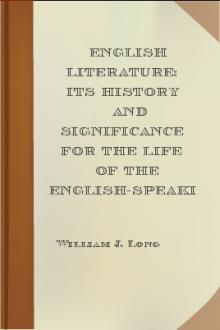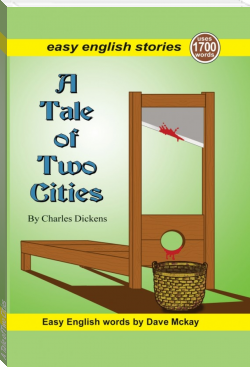English Literature: Its History and Significance for the Life of the English-Speaking World by William J. Long (good books for 8th graders txt) 📕

- Author: William J. Long
- Performer: -
Book online «English Literature: Its History and Significance for the Life of the English-Speaking World by William J. Long (good books for 8th graders txt) 📕». Author William J. Long
Heywood's Interludes were written between 1520 and 1540. His most famous is "The Four P's," a contest of wit between a "Pardoner, a Palmer, a Pedlar and a Poticary." The characters here strongly suggest those of Chaucer.[131] Another interesting Interlude is called "The Play of the Weather." In this Jupiter and the gods assemble to listen to complaints about the weather and to reform abuses. Naturally everybody wants his own kind of weather. The climax is reached by a boy who announces that a boy's pleasure consists in two things, catching birds and throwing snowballs, and begs for the weather to be such that he can always do both. Jupiter decides that he will do just as he pleases about the weather, and everybody goes home satisfied.
All these early plays were written, for the most part, in a mingling of prose and wretched doggerel, and add nothing to our literature. Their great work was to train actors, to keep alive the dramatic spirit, and to prepare the way for the true drama.
3. The Artistic Period of the Drama. The artistic is the final stage in the development of the English drama. It differs radically from the other two in that its chief purpose is not to point a moral but to represent human life as it is. The artistic drama may have purpose, no less than the Miracle play, but the motive is always subordinate to the chief end of representing life itself.
The First Comedy The first true play in English, with a regular plot, divided into acts and scenes, is probably the comedy, "Ralph Royster Doyster." It was written by Nicholas Udall, master of Eton, and later of Westminster school, and was first acted by his schoolboys some time before 1556. The story is that of a conceited fop in love with a widow, who is already engaged to another man. The play is an adaptation of the Miles Gloriosus, a classic comedy by Plautus, and the English characters are more or less artificial; but as furnishing a model of a clear plot and natural dialogue, the influence of this first comedy, with its mixture of classic and English elements, can hardly be overestimated.
The next play, "Gammer Gurton's Needle" (cir. 1562), is a domestic comedy, a true bit of English realism, representing the life of the peasant class.
Gammer Gurton is patching the leather breeches of her man Hodge, when Gib, the cat, gets into the milk pan. While Gammer chases the cat the family needle is lost, a veritable calamity in those days. The whole household is turned upside down, and the neighbors are dragged into the affair. Various comical situations are brought about by Diccon, a thieving vagabond, who tells Gammer that her neighbor, Dame Chatte, has taken her needle, and who then hurries to tell Dame Chatte that she is accused by Gammer of stealing a favorite rooster. Naturally there is a terrible row when the two irate old women meet and misunderstand each other. Diccon also drags Doctor Rat, the curate, into the quarrel by telling him that, if he will but creep into Dame Chatte's cottage by a hidden way, he will find her using the stolen needle. Then Diccon secretly warns Dame Chatte that Gammer Gurton's man Hodge is coming to steal her chickens; and the old woman hides in the dark passage and cudgels the curate soundly with the door bar. All the parties are finally brought before the justice, when Hodge suddenly and painfully finds the lost needle--which is all the while stuck in his leather breeches--and the scene ends uproariously for both audience and actors.
This first wholly English comedy is full of fun and coarse humor, and is wonderfully true to the life it represents. It was long attributed to John Still, afterwards bishop of Bath; but the authorship is now definitely assigned to William Stevenson.[132] Our earliest edition of the play was printed in 1575; but a similar play called "Dyccon of Bedlam" was licensed in 1552, twelve years before Shakespeare's birth.
To show the spirit and the metrical form of the play we give a fragment of the boy's description of the dullard Hodge trying to light a fire on the hearth from the cat's eyes, and another fragment of the old drinking song at the beginning of the second act.
At last in a dark corner two sparkes he thought he seesWhich were, indede, nought els but Gyb our cat's two eyes.
"Puffe!" quod Hodge, thinking therby to have fyre without doubt;
With that Gyb shut her two eyes, and so the fyre was out.
And by-and-by them opened, even as they were before;
With that the sparkes appeared, even as they had done of yore.
And, even as Hodge blew the fire, as he did thincke,
Gyb, as she felt the blast, strayght-way began to wyncke,
Tyll Hodge fell of swering, as came best to his turne,
The fier was sure bewicht, and therfore wold not burne.
At last Gyb up the stayers, among the old postes and pinnes,
And Hodge he hied him after till broke were both his shinnes,
Cursynge and swering othes, were never of his makyng,
That Gyb wold fyre the house if that shee were not taken.
Fyrste a Songe:
Backe and syde, go bare, go bare;
Booth foote and hande, go colde;
But, bellye, God sende thee good ale ynoughe,
Whether it be newe or olde!
I can not eate but lytle meate,
My stomacke is not good;
But sure I thinke that I can dryncke
With him that weares a hood.
Thoughe I go bare, take ye no care,
I am nothinge a-colde,
I stuffe my skyn so full within
Of ioly good ale and olde.
Backe and syde, go bare, etc.
The First TragedyOur first tragedy, "Gorboduc," was written by Thomas Sackville and Thomas Norton, and was acted in 1562, only two years before the birth of Shakespeare. It is remarkable not only as our first tragedy, but as the first play to be written in blank verse, the latter being most significant, since it started the drama into the style of verse best suited to the genius of English playwrights.
The story of "Gorboduc" is taken from the early annals of Britain and recalls the story used by Shakespeare in King Lear. Gorboduc, king of Britain, divides his kingdom between his sons Ferrex and Porrex. The sons quarrel, and Porrex, the younger, slays his brother, who is the queen's favorite. Videna, the queen, slays Porrex in revenge; the people rebel and slay Videna and Gorboduc; then the nobles kill the rebels, and in turn fall to fighting each other. The line of Brutus being extinct with the death of Gorboduc, the country falls into anarchy, with rebels, nobles, and a Scottish invader all fighting for the right of succession. The curtain falls upon a scene of bloodshed and utter confusion.
The artistic finish of this first tragedy is marred by the authors' evident purpose to persuade Elizabeth to marry. It aims to show the danger to which England is exposed by the uncertainty of succession. Otherwise the plan of the play follows the classical rule of Seneca. There is very little action on the stage; bloodshed and battle are announced by a messenger; and the chorus, of four old men of Britain, sums up the situation with a few moral observations at the end of each of the first four acts.
Classical Influence upon the Drama. The revival of Latin literature had a decided influence upon the English drama as it developed from the Miracle plays. In the fifteenth century English teachers, in order to increase the interest in Latin, began to let their boys act the plays which they had read as literature, precisely as our colleges now present Greek or German plays at the yearly festivals. Seneca was the favorite Latin author, and all his tragedies were translated into English between 1559 and 1581. This was the exact period in which the first English playwrights were shaping their own ideas; but the severe simplicity of the classical drama seemed at first only to hamper the exuberant English spirit. To understand this, one has only to compare a tragedy of Seneca or of Euripides with one of Shakespeare, and see how widely the two masters differ in methods.
Dramatic Unities In the classic play the so-called dramatic unities of time, place, and action were strictly observed. Time and place must remain the same; the play could represent a period of only a few hours, and whatever action was introduced must take place at the spot where the play began. The characters, therefore, must remain unchanged throughout; there was no possibility of the child becoming a man, or of the man's growth with changing circumstances. As the play was within doors, all vigorous action was deemed out of place on the stage, and battles and important events were simply announced by a messenger. The classic drama also drew a sharp line between tragedy and comedy, all fun being rigorously excluded from serious representations.
The English drama, on the other hand, strove to represent the whole sweep of life in a single play. The scene changed rapidly; the same actors appeared now at home, now at court, now on the battlefield; and vigorous action filled the stage before the eyes of the spectators. The child of one act appeared as the man of the next, and the imagination of the spectator was called upon to bridge the gaps from place to place and from year to year. So the dramatist had free scope to present all life in a single place and a single hour. Moreover, since the world is always laughing and always crying at the same moment, tragedy and comedy were presented side by side, as they are in life itself. As Hamlet sings, after the play that amused the court but struck the king with deadly fear:
Why, let the stricken deer go weep,The hart ungalled play;
For some must watch, while some must sleep:
So runs the world away.
Two Schools of DramaNaturally, with these two ideals struggling to master the English drama, two schools of writers arose. The University Two Schools Wits, as men of learning were called, generally of Drama upheld the classical ideal, and ridiculed the crude-ness of the new English plays. Sackville and Norton were of this class, and "Gorboduc" was classic in its construction. In the "Defense of Poesie" Sidney upholds the classics and ridicules the too ambitious scope of the English drama. Against these were the popular playwrights, Lyly, Peele, Greene, Marlowe, and many others, who recognized the English love of action and disregarded the dramatic unities in their endeavor to present life as it is. In the end the native drama prevailed, aided by the popular taste which had been trained by four centuries of Miracles. Our first plays, especially of the romantic type, were extremely crude and often led to ridiculously extravagant scenes; and here is where the classic drama exercised an immense influence for good, by insisting upon beauty of form and definiteness of structure at a time when the tendency was to satisfy a taste for stage spectacles without regard to either.
The TheaterIn the year 1574 a royal permit to Lord Leicester's actors allowed them "to give plays anywhere throughout our realm of England," and this must be regarded as the beginning of the regular drama. Two years later the first playhouse, known as "The





Comments (0)